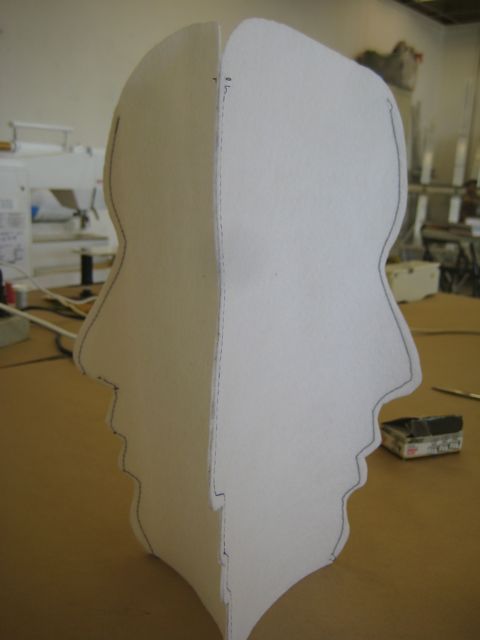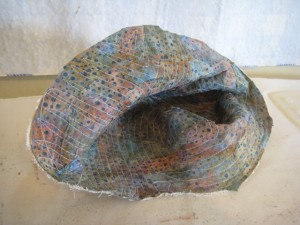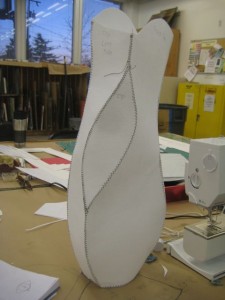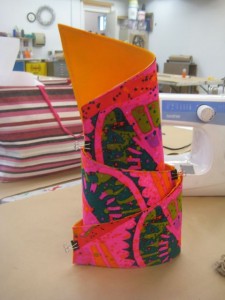I recently attended Reinvention, a conference cosponsored by the Surface Design Association and Studio Art Quilts Association at San Francisco State University. It was my first chance to attend a national conference, and was a great opportunity to meet members of both organizations from outside Washington state. Attendees heard from museum directors and artists their viewpoints about the role of fiber in the art world. And personally, it inspired me to do some hard thinking about my own work.
The conference started with keynote speaker Marci McDade, editor of Fiberarts Magazine, who gave an overview of current fiber exhibitions. Other presenters that day represented museums. Jane Przybysz (pronounced “Prizbee”), of the San Jose Museum of Quilts and Textiles, brought a historical perspective to the question of “What is Fiber Art?” drawing heavily from the book, String, Felt, Thread: the Hierarchy of Art and Craft Through Fiber. Jill D’Alessandro, of the de Young Museum, described the evolution of the Textile Department of the museum.
Stefano Catalani, of the Bellevue Arts Museum, gave a presentation called “Reinvention or Reassertion?: Fiber Art and the Contemporary Identity Discourse.” This presentation was a standout for me because of the artists’ work he showed and because he put their artwork into context by telling the artists’ personal history. He focused the theme of reinvention by highlighting work of three artists who have “reasserted” themselves through the lens of their artwork, Dinh Q Le, Ed Pien, and Mandy Greer. Although each of these artists works in different materials and content, each approaches media from a grounding in culture. Craft is, in each case, a functional part of the meaning.
Later in the day the panelists participated in a question and answer session. The question that caused the most heated discussion was a theory put forth by an audience member that quilt artists are marginalized by their media. The panel’s response was that any media can be successful as long as artists are intentional about how they use it. Mastery and technique do not make the artist; rather they are applicable only in the way that they convey the meaning of the artwork.
Saturday’s sessions started with a dynamic panel of emerging artists: Mung Lar Lam, Lacey Jane Roberts, and Bren Ahearns, moderated by Victor De La Rosa, head of the textiles department at SFSU. Each of the artists works in fiber as a way of addressing gender politics. Mung Lar Lam’s work includes her “Ironings” series in which she performs the act of ironing in an exhibition setting, creating sculptural work by pressing creases into cloth. The performative aspect of the work provides context and a way for the viewer to engage through observation and discussion with the artist. Lacey Jane Roberts knits her artwork using a Sparkle Barbie Knitting Machine, incorporating ideas of gender assignment for children and definitions of craft. Lacey has created barbed wire fences, knitting both the wire of the fence and a pink yarn covering. Her work asks many questions including “Who is being excluded?” and “Who is locked away?” Bren Ahearn uses stitch as a way to question definitions of gender and sexuality, crosstitching “manmade” onto samplers, and stitching images of men cage fighting, bringing the homoerotic nature of this macho sport out into the open for reconsideration in another media.
A panel on environmental art, an historical look at the magazine American Craft, and a talk by four experienced “elders” in fiber rounded out the day. Michael Rohde, a weaver for over thirty-five years, talked about his process and evolution in the craft, moving from his work exploring colorways and pattern to more thematic work. Consuelo Jimenez Underwood, a Latina artist whose life story is as fascinating as her work, talked of finding her voice in political art. Throughout the conference, panels discussed themes including “Art vs. Craft”, messy art vs. mastery in craft, and the perceived disrespect of quilts, and other “women’s work”.
I learned of some upcoming opportunities to get involved in these national organizations. SAQA is looking for a Washington State representative; you may contact Pat Gould, the assistant executive director of SAQA, for more information, at patriciagould@msn.com. SDA is starting an Ambassador Program to get more people involved at the state level. We’ll hopefully be starting a small group of Seattle area SDA members. I’ll relay more information about that as it becomes available.
I would definitely recommend attending a national conference. I came away from the conference reinvigorated about my work. The overarching theme that resonated for me was the necessity of intentionality in art, whatever your media. I tend to work very intuitively, often not verbalizing themes and meaning in my work until it comes time to write an artist’s statement. My new resolve is to be more mindful in my work, bringing meaning to the forefront while (hopefully) still tapping into the intuitive choices I make.





